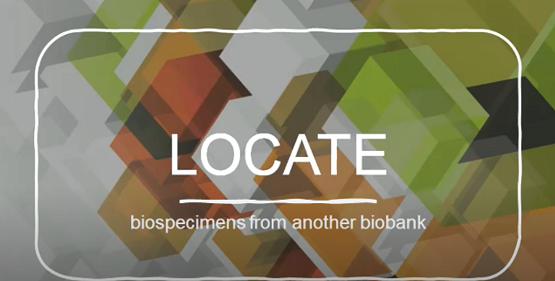Locate
The series of questions you have just answered suggest that the optimal mechanism for you to acquire biospecimens for your current research project is ‘locate’. This means that the type of biospecimens that you require are usually best obtained by locating them in an existing biobank or collection. In this section we will:
- Provide you with a video overview
- Provide a step by step checklist for locating a biobank and accessing biospecimens
- Provide you with an education module describing locating biospecimens from biobanks
- Provide you with access to a biobank locator
- Provide you with supplementary resources
- Address some FAQs related to locating biobanks
We recommend you explore each of the tabs below from left to right. If at the end of this section you still have questions about obtaining biospecimens or more specific questions about the mechanism of ‘locate’ you may contact our help desk at info@biobanking.org
Process
| Checklist | Description |
|---|---|
| Decide what and how many biospecimens do I need? | The first step in the locate process is to identify the number and types of biospecimens that you need for your research study. |
| Use a biobank locator to find a potential biobank | Now that you have determined the biospecimen type and number you need you will need to find a biobank that stores them. Go to our locator tab to search for biobanks that store the biospecimens you are interested in. |
| Contact biobank | When you have selected appropriate biobank(s), you will need to contact them and ask if they currently have biospecimens available and how to apply for them. Many banks have an online request form or you can email. Try to include as much information about the biospecimens you require as you can. |
| Request a meeting with the biobank to discuss specific details of your needs and what kind of biospecimens are available | There are many variables e.g. size of biospecimen available, preservation format, extent of associated data. Therefore it is often best to arrange a meeting with the biobank to discuss the details and obtain advice from the biobank. |
| Apply to ethics board for approval of your study | The ethics protocol template which is in the supplementary resources tab provides wording that you can use to populate your ethics application when using biospecimens from a biobank. |
| Apply to biobank | Complete the application process as per the biobank(s) instructions. The biobank may ask you for clarification or modifications to your application. |
| Review a Material Transfer Agreement (MTA) from the biobank | The biobank will request that you sign a Material Transfer Agreement. This will often require additional signatures from your institution. |
| Arrange and agree on a schedule for the shipping of biospecimens from the biobank to your laboratory | The biobank may ship the biospecimens as a single batch or may prefer to ship in several batches. The associated data may be transferred separately. |
Education
Locator
This section will introduce you to biobank locators and useful search strings you can use for finding biobanks. This section will also introduce you to the concept of cohort locators which can be used to find Tissue Microarrays and other collections.
Click here for the Biospecimen LocatorSupplementary Resources
You will find templates for all of the above and more at www.biobanking.org document templates
Protocol Template
FAQs
- How do I know that biospecimens from a biobank (that I find in the locator) will be of good quality? If you chose to obtain biospecimen from a certified or accredited biobank then you can be confident that the biospecimens have been handled as per the Standard Operating Procedures (SOPs) utilized by the biobank. You can ask the biobank if you can review their SOPs. Several biobanks listed in our locator have been certified by the Canadian Tissue Repository Network (CTRNet, www.ctrnet.ca) and are labelled as such.
- How should I store biospecimens in my own lab before I use them? Before you receive your biospecimens, you should ask the biobank that they come from how they were stored and ideally you should store them in the same manner.
- If there are biospecimens left over after I have completed my study, can I use them for another research project? In most cases you may only use biospecimens from a biobank for the specific research project that you applied to use them before. Most biobanks request that you discard left over biospecimens once your study is complete. Some biobanks ask for any left over biospecimens to be retuned to them. The biobanks that you are working with will describe their policy regarding left over biospecimens in their Material Transfer Agreement (MTA).
- Will my Research Ethics Board allow me to use biospecimens from any biobank? Different Research Ethics Boards (REBs) have different policies regarding the monitoring of biobanks. Some REBs will want evidence such as a biobank certification document to show that the biobank operates ethically. You should ask your REB what documentation they require (if any) in regard to the ethical status of the biobank you are working with.
- Should I include biobank staff as an author on any applicable publications? You should always include the biobank itself and any particular staff members that have assisted you in the acknowledgements section of your publications. Often biobanks provide wording in their MTA that you can paste into the acknowledgements section. Some biobanks have clear policies regarding the circumstances that specific staff members should be listed as an author. You can discuss this with the biobank itself, but the policy regarding this issue should be described in the biobank’s MTA.

